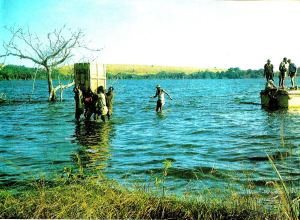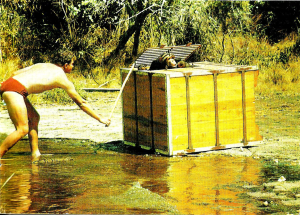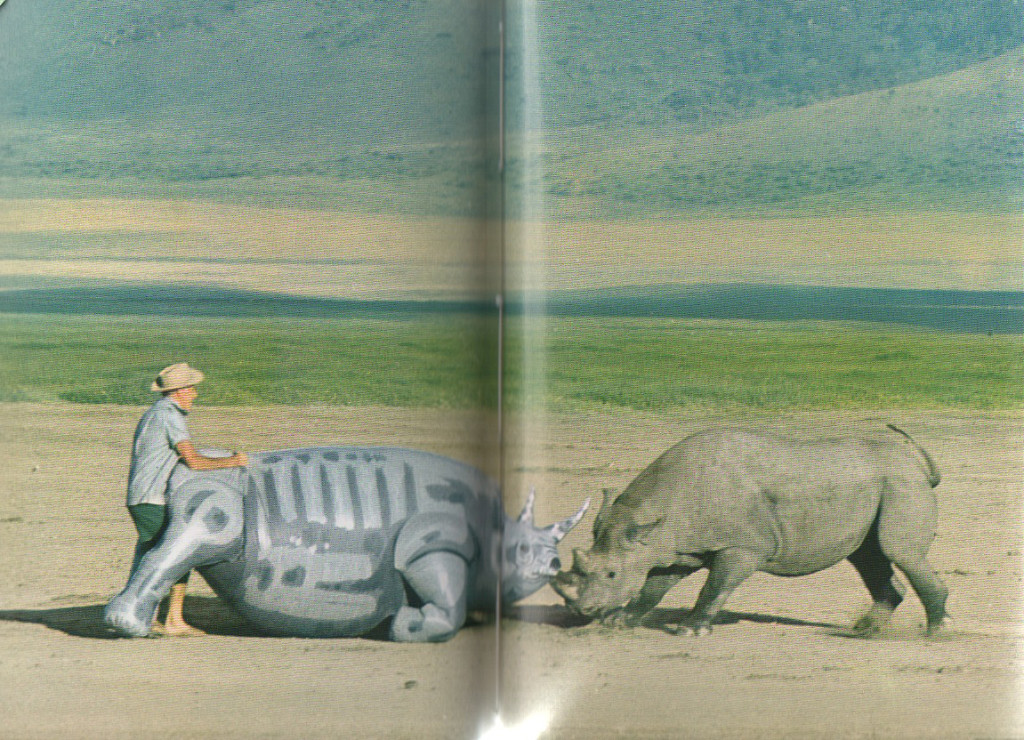Rubondo Island: The African Adventures of Bernhard Grzimek
Bernhard Grzimek (1909 – 1987) was a renowned Silesian-German zoo director, zoologist, book author, editor, and animal conservationist in post-war Germany. He was the Director of the Frankfurt Zoological Garden for almost 30 years, and the president of the Frankfurt Zoological Society for over 40 years. The society – organised on similar principles as its London and New York counterparts – runs a number of wildlife conservation projects both in Germany and overseas; most well known is its ongoing work in the Serengeti ecosystem in Tanzania.
There is a difference between wild animals living a natural life and famous buildings. Palaces can be rebuilt if they are destroyed in wartime, but once the wild animals of the Serengeti are exterminated no power on earth can bring them back. – Bernhard Grzimek
‘Serengeti shall not die’
Grzimek was instrumental in creating and expanding this National Park, following his documentary film “Serengeti shall not die”, for which he won an Academy Award in 1959. He prophesied in his book: “Large cities continue to proliferate. In the coming decades and centuries, men will not travel to view marvels of engineering, but they will leave the dusty towns in order to behold the last places on earth where God’s creatures are peacefully living. Countries which have preserved such places will be envied by other nations and visited by streams of tourists. There is a difference between wild animals living a natural life and famous buildings. Palaces can be rebuilt if they are destroyed in wartime, but once the wild animals of the Serengeti are exterminated no power on earth can bring them back.”
He was actively involved in many conservation projects across Africa, and Rubondo Island features in a few tales of his adventures in East Africa. A chapter in his book “Among Animals of Africa” is entitled ‘How Europe exported apes to Africa’ and details the story of how, in the 1960s, Rubondo Island became a vital sanctuary for endangered wildlife. Grzimek wrote: “I had been introduced to Rubondo by Peter Achard, a game warden based in Mwanza at the southern end of Lake Victoria. Achard felt rather forlorn in this corner of Tanzania: ‘All the tourists and VIP’s go to the Ngorongoro Crater and Serengeti,’ he told me. ‘Nobody comes to Mwanza for a look at my part of the world.”
Exploring Rubondo Island
We boarded a light aircraft and flew the 85 miles to Rubondo. Achard knew what he was doing when he chose Rubondo. I immediately fell in love with the island. It is 24 miles long and on average, 5 miles wide. Three-quarters of its 135 square miles are covered with forest and the remainder consists of grass-covered hills. Above all, Rubondo is uninhabited.
So Rubondo now belongs to the animals. Peter Achard had previously captured sixteen rhinos in other threatened areas of Tanzania, most of them badly wounded by poachers or big game hunters. He had talked the Public Works Department, which is responsible for roads and transport, into bringing a car-ferry big enough to hold ten trucks from one of the neighbouring bays of Lake Victoria and transporting the grey giants to Rubondo in their heavy crates. On one occasion the ferry almost sank. Six giraffes made the trip as well, and one of the rhinos has since produced young on the island.”
Introducing chimpanzees
Sadly, none of these rhinos remain on the island, having been wiped out by poaching in the subsequent decades, but the giraffes and other animals are thriving to this day. On how the first chimpanzees came to Rubondo, Grzimek wrote: “Peter Achard was an energetic and enthusiastic man, and enthusiasm can be infectious even to aging men like me, who really ought to steer clear of adventuring. As a result, the Frankfurt Zoological Society circularised all European zoos and on May 16th 1966 dispatched ten large chimpanzees from Antwerp aboard the German African Line’s steamship Eibe Oldendorff.”
When the ship finally reached Tanzania, he was bemused to note: “The first Dar es Salaam paper I opened when I reached Mwanza contained a photograph of the chimpanzees accompanied by a ridiculous report alleging that the animals, which hailed from European zoos, were accustomed to nothing but the best Russian tea. It appeared that the chief problem would be how to convert them to drinking plain water in the wild. I don’t know which sailor sold this nonsense to the African reporter in Dar, but the same picture and report were reprinted in every German newspaper.”!
Start up problems
The next problem they encountered was how to release the animals once they reached the island, as being habituated to humans, they had no natural fear of people, and some of them were quite aggressive. The solution was to place the crates on the edge of the lakeshore: “We chose a fairly level spot on the shores of Rubondo to unload the crates containing the chimpanzees. Although they had to be manhandled ashore, this gave us the chance to take refuge in the water after opening them. Some of the adult zoo chimpanzees were anything but harmless. One of them had already put a keeper in hospital. Another particularly spiteful male caused considerable mischief on Rubondo eighteen months later.”
Sinclair Dunnet is seen in the picture below, opening the crate with great care. “He could retreat into the water at a moments notice because anthropoid apes are non-swimmers.” In Uganda, on the opposite shore to Rubondo, he had a great idea to assist the game wardens in combating water-borne poachers. Having heard of a German firm manufacturing the Amphicar (an amphibious car capable of travelling on land and water), he ordered one and had it shipped to Mombasa, where he met it and drove to Uganda, always followed by a crowd of curious onlookers! He used the open-topped convertible with great success as a game-drive vehicle in the game reserves, both in and out of the water.
Observing behaviour
“I could have sold my amphibious car three times over to enthusiastic American tourists, probably at a premium, but I and Aubrey Buxton had already made a joint present of it to the Uganda National Parks. It is hoped that their new African director, Francis Katete will put paid to [get rid of] the poachers with its assistance.” In an effort to learn more about the behaviour of large African animals, he convinced a German company to make up life-sized inflatable models of a lion, an elephant and a rhino, which he planned to set out strategically to observe the real animals’ reactions to them.
The lion was quickly deflated by the claws of a curious lioness in the Ngorongoro Crater, and Ian Douglas-Hamilton, the famed elephant researcher, assisted him in placing their dummy in the vicinity of wild elephants, often demonstrating considerable bravery, according to Grzimek. Thus, when the time came to experiment with the inflatable rhino, Grzimek felt he had to demonstrate some bravado of his own, which resulted in the picture below.
“I found it a rather uneasy sensation, confronting an aggressive bull rhino with nothing but a balloonful of air between his horns and my ribs. It soon turned out that the rhino felt almost as uneasy as I did.” It is doubtful that anybody would repeat this experiment in the present day, but in those early years of studying the wildlife of East Africa, it seemed a sensible method in the very early days of the science which has now become known as ethology.
Bernhard Grzimek’s stories are peppered with adventures and the occasional mishap, filled with great humour, and like the naturalist David Attenborough, he was imbued with a huge love of the animals, and a powerful desire to protect and preserve the wild places and landscapes of Africa.
By Ryan Green
Travel writer
Find out more about the Frankfurt Zoological Society on their website.
More Wildlife & Conservation Articles

Leopard vs Cheetah : Can You Tell The Difference
01 April 2020How often do you mistake a leopard for a cheetah or vice versa? I’m sure we’v...

What’s the difference? National Parks, Game Reserves, and Conservancies in East Africa
02 February 2020To most of us, a national park, game reserve, or conservancy are all the same...

Electric Vehicles: The Future Of East African Safari Travel?
12 January 2020October 2019 saw the arrival of our first electric, solar-powered safari vehi...

Guest Gallery: The Serengeti At Its Best
27 November 2019We recently had the pleasure of welcoming guests, Chris and Monique Fallows t...








